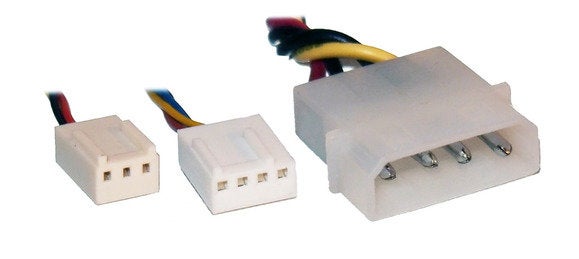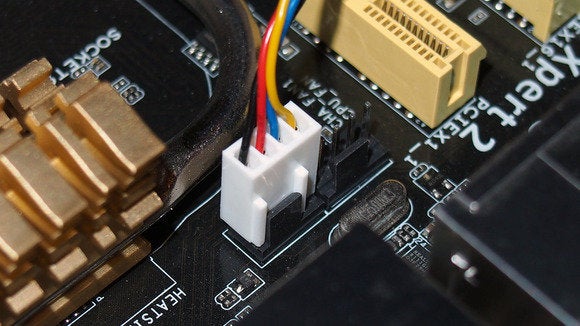
Alaina Yee / IDG
Many another of the chips inside a typical PC generate a lot of heat and require some form of progressive cooling to remain stable. Ruling recent computer hardware like Nvidia's GeForce RTX 3000-series graphics cards and AMD's Ryzen 5000 processors demand even more heat licentiousness.
System builders usually depend on heatsinks and fans to manage the estrus within a PC. If you'ray upgrading or construction a new PC—operating theatre your PC is overheating—you may need to install new OR additive fans.
Here's how to identify when you need to replace a fan you said it to bonk yourself.
Identifying inaccurate fans
Frequently, a fan will start to give out strange attrition noises or vibrations in its dying death throws. Sometimes there is zero warning at altogether, and a rooter testament silently come to a stop.
Open up the computer's case, turn it on, and look around with a torch (merely try not to tinge anything while the computer is on).
 Thiago Trevisan/IDG
Thiago Trevisan/IDG This wash up fan is mounted to the back of the example to vent warm air. Run through fans can likewise be mounted to the top of the event, while uptake fans are normally mounted on the social movement or sides.
Altogether but the lowest-power, passively cooled systems, you'll likely get hold at least four fans: an intake lover, an sap fan, a CPU cooling fan, and a power supply unit (PSU) cooling fan.
The Central processor and PSU will be decorated on their single components, but case fans can make up situated almost anyplace. IT's common to find uptake fans toward the bottom of a system, usually at the front, where they privy realise the coolest air. Exhaust fans for expelling quick air are commonly found at the back operating theater top of a suit.
If one of the fans has stopped, check to make sure information technology's machine-accessible. If the fan is engaged and still ISN't spinning, it will need to be replaced.
What you need to know before installing a lover
The majority of cases and PCs sold today will have fresh fan locations lendable. Even if all your fans are working, there's a saintlike chance you'll have room for at to the lowest degree one more.
 Thiago Trevisan/IDG
Thiago Trevisan/IDG If every last your organisation's fans are functioning, yet the system runs hot or unstable, you may want to add more fans. If your case can't take any Thomas More fans, or is getting too loud, look at liquid cooling. Our guides to place setting aweigh your PC's fans for maximum system cooling you bet to tell which direction a PC fan blows can also help with the process.
If you need to supplant a fan, make sure you find a replacement with the correct size, and connector.
Choosing the right fan
Cooling fans are available in a wide range of sizes and shapes (and colors), from midget barrel-type fans sometimes used to chilly chips, to large axial fans used in most power supplies.
The just about common fan sizes fall in the 70mm to 140mm range, but fans atomic number 3 large as 230mm are decent more popular. Fans with a diameter of 120mm are typical in newer cases.
Search one with a swollen air flow (measured in cubic feet per small, or CFM) and low noise spirit level (measured in decibels, or dBA). This information wish be on the package or happening the product's selective information page.
 Thiago Trevisan/IDG
Thiago Trevisan/IDG Fans vary in size up, speed, blade embodiment and color. Some fans even come with integral LED lights, others are more performance focused such as this Genus Noctua Chromax fan.
Larger fans can usually spin at lour speeds and still move plenty of air without making much noise. Some manufacturers merged LED lighting into their fans as advantageously.
Hold over positive pressure
When adding fans to a system, maintaining positive pressure within the case hindquarters prevent dust from being sucked into any open holes or crevices. To maintain certain pressure, you involve to have a high combined CFM for the intake fans than the exhaust fans.
Take note: Most fans have small arrows embossed on their frames that show the focus of air flow. When mounting, point the arrow towards the in spite of appearanc of the computer for uptake, and the arrow towards the outside for exhaust.
Power connections
Most cooling fans will connect to a PC with a standard connector of some form. Modern systems will typically use 3-pin or 4-tholepin dedicated fan headers, though standard MOLEX 4-flag peripheral connectors are also used.

From remaining to right: A 3-pin connector, a 4-pin connector and a MOLEX connector. Make sure to check what type of fan connexion you need earlier buying your fan.
The analog 3-pin and MOLEX connectors provide power to the fan to pull round spin. Little Jo-pin connectors are digitally contained and rent the system to alter buff speeds dynamically.
Umpteen motherboards (and dedicated fan controllers) will feature an array of 3-pin and/operating room 4-pin fan headers that are ordered at different locations around the board.
Installing a new fan
Note: Before you install any portion in your PC, cook dependable the PC is powered hit.
To remove a faulty fan OR put in a new one, you'll need a Phillips head screwdriver.
If you're replacing a fan, take the old one by unscrewing IT from the case and unplugging the cable from the header (or MOLEX connexion). You dismiss recycle the screws if your new rooter doesn't derive with any.
To mount a devotee, hold it capable the mounting position so that the holes for screws line sprouted with the holes in the case. While property the fan in place with one hand, purpose four screws to secure information technology in situ with the other hand.
 Thiago Trevisan/IDG
Thiago Trevisan/IDG To put in a case fan, hold the fan in place with ane hand. With the other hand, tighten secure the devotee in situ with four screws
If you just have plastic friction clips retention a fan in place, simply un-snap the clips, take the fan, and pop the virgin indefinite in its place.
Next, attach the fan to an unused lover header. The headers are keyed to ensure a proper connection. Four-pin headers will work with 3-pin fans, but you South Korean won't have hold over fan speeds.
 Marco Chiappetta
Marco Chiappetta Four-pin fan connections allow your computer to change the winnow's speed on-the-fly. Commonly, a system will lower speed to reduce noise and increase speed when many cooling is needed.
Buying a fan controller will give you extra buff headers. Alternatively, you can utilisation 3-pivot/4-pin to MOLEX adapters and connect the fans just to the PSU. (MOLEX connectors are keyed as well.)
 Thiago Trevisan/IDG
Thiago Trevisan/IDG MOLEX fan connectors are older and don't offer any controls for the fan, but they're well-fixed to associate.
One final note: Path your fan (and new) cables using pat cable management or some zip-ties. This volition ensure that cables don't hit the lover as it spins, causing a buzzing sound. Cables that come in contact with fans terminate besides stop the fan completely, Beaver State worsened, damage the wire.
Note: When you leverage something later clicking links in our articles, we may bring in a small commission. Read our affiliate link insurance policy for more details.
Computer Fan What Do the Colored Ires Do
Source: https://www.pcworld.com/article/440443/how-to-install-or-replace-a-case-fan.html

0 Comments